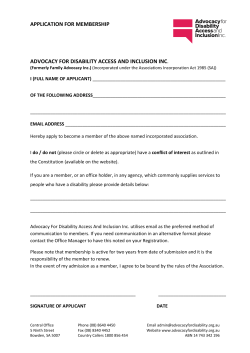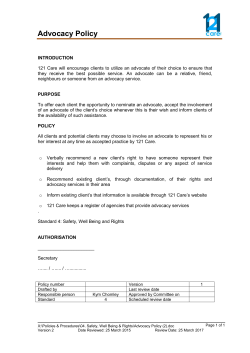
Advocacy Planning to Achieve Your Goals
Introduction to Strategic Advocacy Presented by: Purnima Chawla Center for Nonprofit Strategies http://cnpsweb.org Definitions of Advocacy To build support for a particular cause or policy. To participate in a process to influence decisionmakers in a political, social or institutional system. Advocacy can mean… • Raising the urgency of an issue/problem • Promoting your perspective on the issue (or that of your beneficiaries) • Developing policies to address the problem • Promoting a particular policy or solution • Ensuring effective implementation and enforcement Why Strategic Advocacy • • • • Better use of limited resources Simplifies decisions Minimizes risks Ensure coherence and credibility 4 Can you be both strategic and opportunistic/responsive? A strategy is a road map (not a checklist). It enables you to correct course and adapt quickly. 5 Strategic Advocacy Goals and Objectives Measures Key Relationships Role and Style Strengths/Resources Strategic Advocacy Goals and Objectives Measures Key Relationships 1. Setting goals and objectives Role and Style Strengths/Resources The big problem you’re trying to solve. e.g. End marriage of girls under 18 years Goals and Objectives Specific changes that you can bring about to help reach that goal. E.g. • Passage of law prohibiting underage marriage • Better enforcement of such laws in your state or district • Laws mandating school attendance for girls • Efforts by local school districts to keep girls in school • More funding for youth programs to empower girls Setting Advocacy Goals How does advocacy fit with your organization’s mission and programs? – Facilitate your programs (e.g. more resources) – Spread your ideas or perspective – Raise the profile and credibility of your organization – Ensure your constituents get what they need 9 Limiting Your Goals What is the range of goals you will work on? – How deep/wide is your advocacy effort? – Is it aligned with your resources? – What are the risks of engaging (or not engaging) 10 Choosing Objectives • What specific decisions are you seeking right now? Who will do What and When. Why objectives are smarter? Specific Measurable Attainable Realistic Time-bound 11 Strategic Advocacy Goals and Objectives Measures Key Relationships 2. Defining your role and style Role and Style Strengths/Resources 2. Defining Your Role and Style How you will participate in advocacy? – Where (what levels and forums) – Ideological vs. pragmatic – Single objective vs. opportunistic – Confrontational/Insider/Friendly critic – Start/join a campaign? – Start/join a coalition? 13 Strategic Advocacy Goals and Objectives Measures Role and Style 3. Mapping your advocacy strengths and resources Key Relationships Strengths/Resources What qualifies you to be an advocate? Your passion for the cause Everything else can be learned or developed. 15 What makes you an effective advocate? – Knowledge/expertise – Experience in the field – Authority to speak for a group of people (formal or informal) – Ability to mobilize/influence a group of people – Ability to frame messages, communicate ideas – Relationships and access How will you use, maintain and cultivate these sources of “power”. 16 Strategic Advocacy Goals and Objectives Measures Role and Style 4. Mapping key relationships Key Relationships Strengths/Resources 4. Key Relationships • Constituents—the people whom you represent • Activists—the people whom you can mobilize to act • Target audiences—those who make the decisions (corporations, legislators, government agencies) • Influencers—those who can influence the decision-makers • Allies—the organizations that work with you • Opposition—organizations that work against you 18 Advocacy is about cultivating, managing and using relationships Staying connected with those whom you represent Faithful representation, increased ability to empower and mobilize them. Developing alliances with organizations who share your goals Amplified voices Cultivating relationships with decision-makers and influencers (e.g. media) More access and influence Growing and inspiring your base of activists More power and credibility Understanding the opposition Converting or neutralizing 19 The Stakeholder Map is a useful way to organize the landscape Positive influence, with Similar culture and values Positive influence Different culture and values Natural Allies Potential Allies Advocacy Goal Weak influence now But potential to be mobilized. Potential Constituency Negative influence Must be neutralized or persuaded Opposition 20 Your Basic Strategy • Whom will you influence? (target audience) • What do you want them to do differently? • How will persuade them to do this? Argument A Reason to Act 21 Strategic Advocacy Goals and Objectives 5. Learn and improve Measures Key Relationships Role and Style Strengths/Resources Why Monitor Advocacy To track ongoing progress in a long battle To facilitate collaboration To adapt the action plan To update your knowledge of your strengths, the landscape, and decision-makers To know if you are faithfully implementing the strategy To test the strategy itself To report on your achievements and secure funds 23 What you should monitor • Outputs • Process measures • Outcomes (milestones towards ultimate objective) • Advocacy resources (update stakeholder map) Record expected and unexpected outcomes. 24
© Copyright 2025









